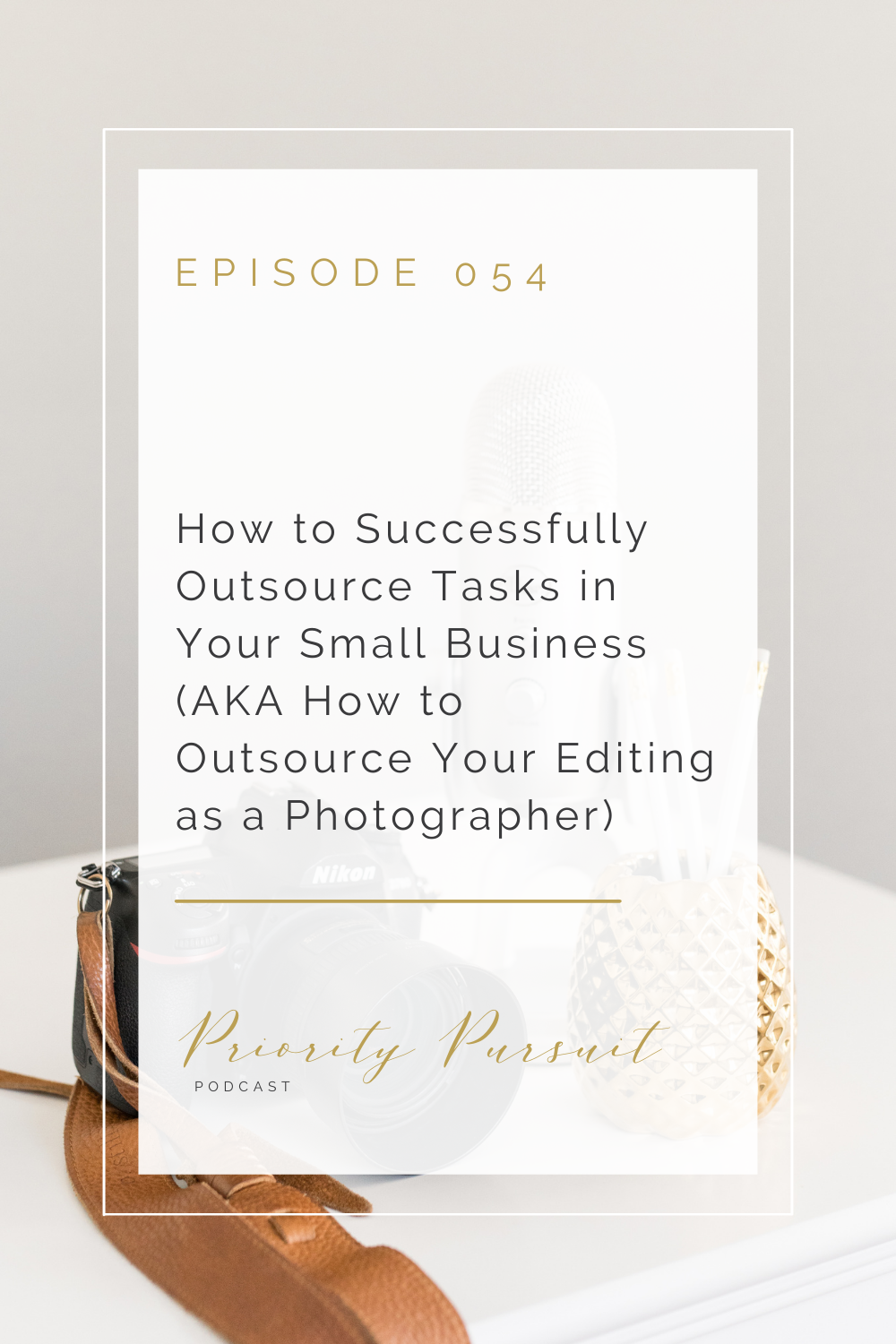Let's Connect!
Check Out Wedding Photography Packages]
I understand how much your wedding photos mean to you and how much work you’re putting into planning every last detail of your big day. As a VRP bride, you can relax and enjoy your wedding day knowing you’ve chosen a team of photographers who are just as detail-oriented as you are, will put thought into every shot, and will pay attention to all of the little details to ensure that you and your spouse love your wedding photos.
And, I’m an Indy wedding photographer for the type-A bride.
I'm Victoria Rayburn
Hey there!
Episode 054: How to Successfully Outsource Tasks in Your Small Business (AKA How to Outsource Your Editing as a Photographer)
Spotify | Apple Podcasts | Stitcher
Do you have too much on your plate? Can you simply not get everything done? Or, would you like to just work less?
If you answered “yes” to any of these questions, my friend, chances are, it’s time to outsource something in your business.
Now, I know what you’re going to say. “Outsourcing isn’t an option for me. Nobody can do __ like I can.”
However, friend, the reality is (1) you cannot grind and do everything in your business forever and expect to grow, and (2) there are things on your to-do list that can be done by others. And, I know you hate to hear this, but chances are, there are things on your plate that can be done better and more efficiently by others.
With this in mind, in this episode of Priority Pursuit, we’re discussing how to successfully outsource tasks in your small business. And, because I’m a photographer and I know that there are several photographers listening, I’m going to explain how I outsource editing with Photographer’s Edit to give us an example to work with.
1. Determine what you truly can & can’t outsource.
If you’d like to begin outsourcing, the first thing you need to do is make a list of everything you’re currently doing in your business. From developing social media content to sending client gifts, write every task down.
Then, go through that list and determine which tasks you personally have to do and which tasks you could either teach someone else to do or hand off to a professional with a niche in that area. (I learned this from Brendon Bruchard’s book High Performance Habits by the way.)
Just to give you an idea of my outsourcing list, I outsource the editing of podcast episodes, show notes for all interview episodes, album design, web design, graphic design, Pinterest, adding blog posts to my website, submitting my weddings for publication, packaging and mailing client gifts, and—believe it or not—photo editing.
At one point or another, I handled all of these things personally. Well, besides the podcast editing part. I started Priority Pursuit knowing I’d need help. But, over the years, I’ve realized that there are only a few things in my business that I have to be the one to do (e.g. be the voice of this podcast), and when I let go of the things I don’t have to do, I give myself the capacity to work less, accomplish more, better serve my clients, and actually enjoy my job.
2. Create SOPs for the project or task you want to outsource (AKA establish your editing style).
Now, before you can begin outsourcing, it’s important to have SOPs (standard operating procedures) in place. In other words, you need to have an exact process and parameters or guidelines for the task you want to outsource.
Need help developing workflows & SOPs? Tune in to “Episode 051: How to Have a 20-Hour Work Week as a Creative Entrepreneur with Laura Murphy of Laura Lee Creative”!
For example, before I could outsource my editing, I had to determine my editing style and more or less make rules that define what a VRP photo looks like.
For instance, when I edit photos, my goal is to have light and airy photos with natural skin tones, and this is achieved largely by raising shadows, bringing down the saturation of greens and yellows, bringing up the luminance of yellows and greens, raising the exposure until images are one stop from being overexposed, and bringing down highlights so nothing looks washed out. When I crop photos, I am to straighten, crop out distractions, and ensure that there’s a strong focal point of each image. And, when I crop tighter photos, I want to make sure that they’re never cropped at a joint. I either want my subjects’ full bodies showing or to crop at the midthigh or—if it’s a very tight, snuggly photo—the waist or wherever is most flattering for that particular client.
Basically, because I have a process and system for editing photos, I can teach others to edit my images in the same way—or at least get them really close.
Regardless of what you want to outsource, if you want to successfully outsource tasks in your small business, you have to develop SOPs so that your expectations are clearly set. (Side note: Even if you aren’t outsourcing, having SOPs is important so that you can work efficiently. Learn more about SOPs and why they’re critical in “Episode 051: How to Have a 20-Hour Work Week as a Creative Entrepreneur with Laura Murphy of Laura Lee Creative”!
Now, the one exception to this step is if you intentionally outsource something knowing that you never want this task to be on your plate and are willing to trust someone else to design the process for your business.
For example, I’ve never edited the audio of an episode of Priority Pursuit. I outsourced this task to Kelsey and trusted her expertise as a professional podcast manager to set the system. As a result, I didn’t need to develop an SOP for podcast editing.
Long story short, to successfully outsource tasks, you either need to develop a clear process or trust someone to develop a process for you.
3. Decide who you’re going to outsource this task to.
Once you have a process in place and clear expectations set, you need to choose who you’re going to outsource to. And, whether you realize it or not, you likely have several options.
For example, you could hire a virtual or personal assistant who handles or is willing to learn all kinds of tasks. You could hire a college student or someone looking for part-time work and teach them how to do the task. Or, you can hire a professional or team with a niche in the specific task, which is what I did with Photographer’s Edit.
When it comes to choosing who you should outsource to, there isn’t a right or wrong option. That said, I recommend weighing the pros and cons of each option on a project-by-project basis.
For instance, when I decided to outsource my editing, I decided I’d rather outsource to a professional editing team than teach someone looking for part-time work with no Lightroom or Photoshop experience how to edit my photos, because I knew teaching someone without any photo editing skills was going to take time I didn’t have.
Photographer’s Edit, on the other hand, edits for thousands of photographers and has the knowhow to adjust to any photographer’s editing style. As a result, this made the most sense for this project.
However, something else I outsource is the packaging and mailing of client gifts. And, this is something my friend Mariah—who is primarily a stay-at-home mama—does for me a couple hours a week. With 20 couples a year, I don’t need a warehouse or team of people to send these items. I just need someone who is highly organized and timely, which Mariah is.
Again, when choosing who you’re going to outsource to, there isn’t a wrong answer. You just need to decide what individual or business is right for the task on a project-by-project basis.
4. Provide examples.
After you’ve developed SOPs and chosen who you’re going to outsource to, it’s important to provide examples so that the contractor has samples to refer to.
For example, when Emma (my virtual assistant) came on board and I had her start using BlogStomp to add photos to blog posts from shoots and weddings, I was able to show her past blog posts that she could look to as examples.
Then, with photo editing, I actually give Photographer’s Edit sample images for every wedding and shoot. My personal editing process is to only edit the images that I blog and then let Photographer’s Edit handle the rest. This (1) allows me to blog photos quickly after a wedding or shoot and (2) gives Photographer’s Edit samples to work from so that my expectations for the final results are clear.
Photographers, when you place an order with Photographer’s Edit, you can specify your editing preferences in one of three ways: you can use one of Photographer’s Edit’s editing styles; you can have them edit to your editing style (meaning they look at sample images added to your profile and edit based on those samples); or you can edit a portion of the images from the specific shoot and ask Photographer’s Edit to use the edited images as the samples to work from.
There isn’t a wrong option, but for me, I’ve found that editing images from the shoot is more likely to lead to final images that I love. Plus, this option fits best in my workflow.
5. Give feedback & allow the contractor who did the work to make corrections.
After your contractor has completed the task or a draft of the task, I want to encourage you to remember that your contractor is human.
When you first start outsourcing a task, it will likely take a while for you and your contractor to get on the same page. Unless instructions clearly weren’t followed, don’t get frustrated if a project isn’t completed perfectly—especially the first few.
Instead, provide feedback, talk to the contractor to see if maybe some of your instructions were unclear, adjust or clarify SOPs if needed, and allow the contractor to make the edits. This will help the contractor better understand what you’re looking for in the future and lead to results that better serve your business.
When I get an order back from Photographer’s Edit, I’m always sure to leave feedback. Over the years, this has led to edited images that are increasingly closer to my exact preferences. Plus, when you leave feedback, you get credit you can put toward the cost of future editing!
6. Anticipate that a few changes will need to be made.
Now, I do want to bust an outsourcing myth. Just because you outsource something does not mean that you won’t need to make final edits or adjustments. And, in my opinion, this shouldn’t be surprising.
I mean, when I was a copywriter back in the day, I’d be assigned a project, and before anything I wrote was published, it was reviewed by at least three people and went through at least three rounds of edits.
With this in mind, it’s unfair for us as creative entrepreneurs to expect outsourced projects and tasks to come back absolutely perfect every time, and it’s naive of us to think we won’t need to make little changes and adjustments.
For example, when I get an edited gallery back from Photographer’s Edit (They send photos back in a Lightroom catalog.), I don’t simply export the photos. I go through each and every image to double check them, make small adjustments, and add finishing touches.
Now, you might be thinking, “If I have to go through the project anyway and make adjustments, why would I bother outsourcing?”
And, friend, I would argue that if you can find a contractor who can get a task or project 90% of the way there, being able to save yourself 90% of the time you would’ve spent on that task is truly incredible and will lighten your workload significantly.
7. Enjoy having more time on your hands!
Like I mentioned at the beginning of this episode, you cannot do everything in your business forever. And, when you insist upon personally being responsible for each and every task, you are inhibiting your ability to serve your customers well and your business’s growth.
For years, I told myself things like, “I don’t need to outsource, because I’m an efficient person,” “I don’t want to outsource, because I know nobody will be able to meet my standards or do things as well as I do,” and, “I can’t afford to outsource.”
But, I can honestly tell you that outsourcing is what has allowed me to deliver images to my clients quickly, blog every wedding and session, make more money, and work on things that excite me—like this podcast.
I know your business is your baby, and just like a parent of a human, you want to make sure your baby is safe, well cared for, and thriving. But, sometimes, parents need a break or extra help—which is why grandparents, babysitters, and medical professionals exist.
Like it takes a village to raise a child, it takes a village to run a business.
With this in mind, if you have more on your to-do list than you can handle or if you have a project you’re dreaming about starting but just don’t have the capacity to get it done with your current workload, I want to challenge you to outsource at least one thing in your business. Because, my friend, you now know exactly how to successfully outsource tasks in your small business. So, what are you waiting for?
Photographers, receive 50% off of your first order from Photographer’s Edit!
Photographers, if you’re ready to outsource your editing, I have a little something for you: a code for 50% off your first order of $30 or more from Photographer’s Edit! Simply click here or use code “vrayburn” at checkout to apply the discount!
Just as a heads-up, I highly recommend becoming a Premium Photographer’s Edit Member. While you can place a one-time order with Photographer’s Edit, when you become a Premium Member, you’ll:
- Work with a dedicated editing team every time you place an order, which will give you more consistency.
- Receive faster turnaround times.
- Be able to schedule orders in advance, which is particularly helpful during busy seasons.
- Have the option to purchase editing credit at a 10% discount.
Again, to receive 50% off your first order from Photographer’s Edit, click here or use code “vrayburn” at checkout so you can live more, edit less, and dream bigger!
Links & Resources Mentioned in This Episode
Receive 50% Off Your First Order with Photographer’s Edit
Save 50% on Your First Six Months of Quickbooks Self-Employed
High Performance Habits by Brendon Bruchard
Join the Priority Pursuit Facebook Community
Follow or DM Victoria on Instagram
Did you enjoy this episode? If so, pin it to save it for later! Follow me on Pinterest for more marketing, business, branding, and boundary-setting strategies!

Let's Connect!
Check Out Wedding Photography Packages]
I understand how much your wedding photos mean to you and how much work you’re putting into planning every last detail of your big day. As a VRP bride, you can relax and enjoy your wedding day knowing you’ve chosen a team of photographers who are just as detail-oriented as you are, will put thought into every shot, and will pay attention to all of the little details to ensure that you and your spouse love your wedding photos.
And, I’m an Indy wedding photographer for the type-A bride.
I'm Victoria Rayburn
Hey there!
© 2023 Victoria Rayburn Photography. All rights reserved. | Terms & Conditions | Privacy Policy
Let's Connect!
@victorialrayburn
Let's Connect! | @victorialrayburn
Schedule a Coffee Date
However, as a VRP bride, you can relax and enjoy your celebration while being confident that every moment and detail is being thoughtfully photographed!

